Kids Web Japan
Web Japan > Kids Web Japan > Meet the Kids > Komei > Classes
Meet the Kids
Komei School for the
Physically Handicapped
In Class (High School Students)
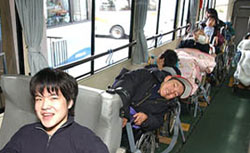
The school buses have no steps and are easy to board and exit for students in wheelchairs.
Each day begins at Komei with the arrival of 13 school buses. Beginning at around 8:30, school buses arrive one after another, pulling into what looks like a dock for boats. Each bus, which carries about 10 students, pulls into a space specially fitted with a kind of flat bridge that links the vehicle to the school area, allowing students in wheelchairs to exit the bus and get to school without having to go up or down any steps. The teachers come out to meet the students and escort them to class. With all of the people and wheelchairs moving around, morning at Komei looks like a traffic jam at rush hour.
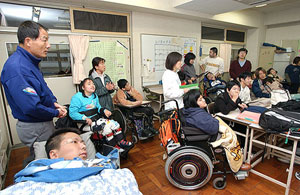
Students go over the day's schedule in the morning class meeting.
Among the kids arriving are the high school students. Today they have English during the first hour, and they study elective subjects (classes they have selected themselves) during the second and third hours. Afterwards, they have lunch, and they leave school at 1:30.
The morning starts with homeroom at 9:00. Unlike the other classes, where students are separated according to ability, homeroom brings all the students of a given grade together. The teachers check attendance and confirm the day's schedule, and the students all sing the song of the month together. (The students sing a different song every month.) Homeroom finishes at 9:10, and the students break into five different groups for their first-period class, which starts at 9:15.
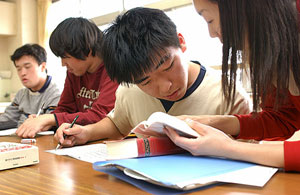
Writing a letter in English is difficult, but the students work hard to convey their thoughts.
First period today is English, and a look inside the classrooms of group five reveals that some students are studying how to write letters in English, while others are reading an English text. During the 50-minute class, the students in the letter-writing group carefully compose a message to a middle school student in New Zealand in which they introduce themselves and explain in English about their hobbies and general things about Japan. Student Yukio Nakamura explains, "Looking things up in the dictionary is a lot of work."
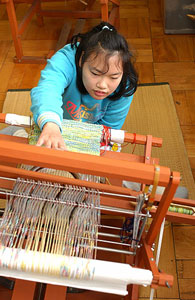
Satomi Yoshida skillfully weaves a muffler.
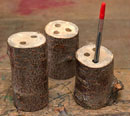
Inkstands created by students and made from the branches of a cherry tree.
Second and third period classes are electives, and students are allowed to choose among arts and crafts, industrial arts, or computer science. The arts-and-crafts class is in the middle of learning about weaving.
The students select and combine the different colors of thread they like, and they then operate a special machine that allows them to make fabric without using their hands. Then they make things like scarves and handbags using the cloth they have produced. The class enjoys a wide range of activities, as they also make felt from virgin wool and work on producing bead accessories.
The industrial-arts class, meanwhile, is busy with woodworking. Today the class is cutting the branches of a cherry tree into 10-centimeter (4 inch) segments to use as inkstands. Toshihisa Yoshimura of group four smiles as he holds down a branch with a vice and cuts it with a saw. He says, "Cutting and making things is fun." So far students in the class have made things like coasters, nameplates, picture frames, and key holders. They are free to take home the things they have made, and the students give them to family members as presents or use them for themselves. As the students can see the tangible results of their efforts, industrial arts is popular with students.
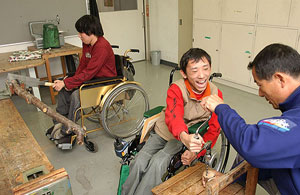
Making things is fun!
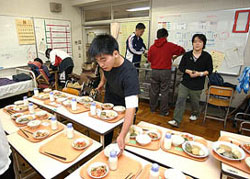
When the morning classes are finished, the students go back to their homerooms with the other students of the same grade, and each class has lunch together. While the lunches are prepared in a kitchen in the school and then brought to the different classes, the enticing aroma of freshly cooked food fills the schoolhouse. Today's menu is oden (a kind of stew), vegetables and shrimp marinated with plums, rice with vegetables, and milk. Lunch is the favorite time of the day for most students, but some of them have difficulty chewing and swallowing. The teachers assist these students by cutting their food into tiny pieces using scissors or even mixing it up in a blender to make it easier for them to eat. For the students who are unable to use their hands, the teachers help out by feeding them little by little with a spoon.
When lunch is over the day's schedule has come to an end, and the students board the school buses that take them back home.